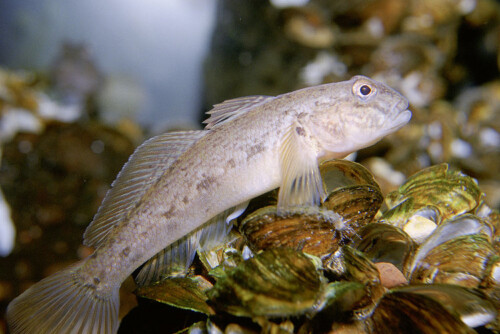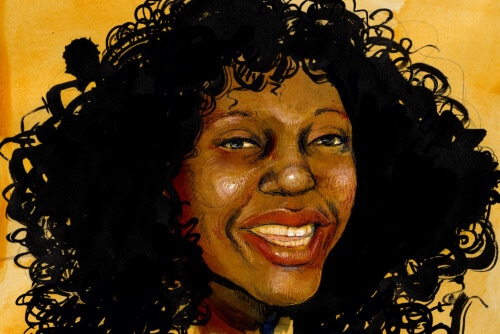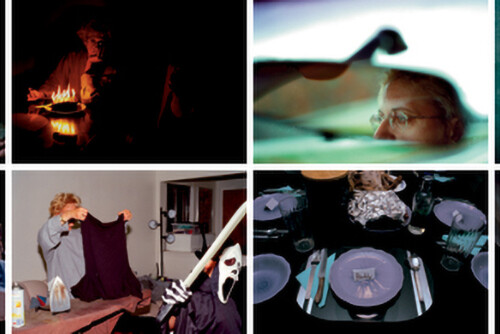Kathleen: I have a follow up question about sci fi—how does sci-fi influence your work?
Ela: We love fantasy, especially sci-fi. We loved Bladerunner and La Jetée, both in terms of form and storytelling. And Gattaca. Gattaca was especially appealing not just for the storyline, but because when we were writing the film script, we used it as a model. The ideas were complex, but the settings were doable, they were not impossibly expensive.
Carmelita: Gattaca is about a character that aspires to be an astronaut but his genetic composition determines his lot in life and he cannot be one. In Chicas, the chusma gene also determines what you can do in life and how you are classified. In both that work and Post Plastica, there is a transspecies, hybrid woman-bear, named Ursa in Post Plastica, whose genetic make-up makes limits and challenges.
When the main character, Ho, a down-and-out artist goes to bed with Ursa, she discovers Ursa has a tail and that she is part bear. Ursa talks to Ho about her life and how as a hybrid she has few civil rights. In that sense we were trying to make a connection with the new immigrant class. Maybe in the future, Latinos won’t be the ones discriminated against; maybe that concept won’t exist. However, there will be other concepts, classifications like transspecies, who may be subject to discrimination and their civil rights will be curtailed.
And we were thinking of the animal species. What rights do they have? What rights do we have to make use of them in the ways that we do? Concepts change as we learn more about animals. We used to think animals didn’t use tools and that has changed. We are learning more about animals and how they communicate and what constitutes language. Animals are integral to our planet. We have lost many species and may lose more. The possible disappearance of bees has brought about a vibrant community of people that have become urban beekeepers.
Kathleen: It’s fascinating that you take up these serious issues but make them very funny.
Ela: Well, humor—we both deal with humor. In Spanish, we call it choteo, which is poking fun. It is irreverent humor that mocks authority. It is the kind of humor that we are steeped in as Cubans—it is our Caribbean culture.
Even in my documentary, La Lupe Queen of Latin Soul, which was produced for public television, humor is used to deal with race and class. When La Lupe appears on Dick Cavett’s show and she turns around to reveal butt crack décolletage, there are always laughs. She jumps and even picks up Cavett, who plays along with her. But this was in the early 70s and it was daring for the times. Cavett explains that he received calls thanking him for having her on the show, she’s “one of us.” She’s fierce and trashy.
Carmelita: Chusma.
Ela: Chusma as you can be, but you get the feeling that La Lupe was fully aware of what she was doing and how she was presenting herself. La Lupe herself was funny, and the sequence is edited to highlight her humor, but also to question class and race and gender on public television as you’re laughing. We use humor consistently. But we believe humor is serious.
Carmelita: Yes. You can poke fun at just almost everything. Humor is a tool. It’s a different way to attack a problem. So that said, I think that we could have made Post Plastica funnier. But that’s not the tone that we were going for. In Memorias de la Revolucion, Uzi Parnes directed a musical number where Lisa Kron was dancing with—
Ela: Kate Stafford.
Carmelita: Who plays Capitan Maldito (Captain Damned).
Ela: There’s a moment where it could be funny, but it’s actually dangerous. And it’s that moment where you don’t know—am I going to laugh or is this really threatening? That’s the kind of moment that we were going for in Post Plastica.
Kathleen: Let’s talk about Chicas’ non-consexsual cloning act, your fascination with cloning, humanity, and the woman oso. What about this interest in hybrids and cloning, and bears? About the bees and the bears?
Carmelita: Again, we have different readings of it. We were thinking bears are endangered. There is global warming and it’s hard for them to hunt. Are they going to be extinct? Or survive? How? We were thinking of bears as the animal species.
But we were also thinking of the queer connotation of bear, the homosexual male who’s big and hairy, not a manicured, pedicured metrosexual. In the queer world, bears are natural, wilder and feral in appearance. So I love the fact that there are multiple readings of bear.
Ela: Teddy bears are important in my feature Latin Boys Go To Hell and in Carmelita’s collaboration with Marga Gomez, Single Wet Female.
Kathleen: And what about the whole idea of companion species that become us through the cloning, through the stories you’re telling in these performances?
Carmelita: The companion species—what is that? I’m not sure I—are we talking about our new significant others or pets?
Kathleen: Pets. Companion species are animals that are domesticated and live with us.
Carmelita: We’ve always thought that in the queer family, for those that don’t have children, their animals are their babies.
Ela: Fur babies, our friends call them fur babies. In the queer community, animals are companions. And when I say queer, it could be heterosexuals that don’t have babies, who love their animals just as much. So it’s a very broad way of thinking about animals.
Kathleen: So you perform issues in biotech and biopolitics, through the hybrids, the clones. Can you talk about your interest in that alongside of your verbal cloning? You use a lot of puns. Both of you write with a lot of puns. And that’s kind of a linguistic clone, if you will. They’re identical, but they’re different. And so I just wondered if you could talk a little bit about language and your writing process.
Carmelita: Well, I love language in terms of puns and double entendres. Saying one thing and meaning two. In a way, puns are—I think—a kind of hybrid. And in terms of animals, I’ve used animals throughout my work starting in 1991. I co-wrote with Uzi Parnes a piece called The Conquest of Mexico as Seen Through the Eyes of Hernan Cortes’s Horse.
And then again in Milk of Amnesia, there was a horse, who is a witness to a brutal colonial history in Cuba. I’ve been interested in using animals to tell history. My solo, With What Ass Does the Cockroach sit?, which is about Elian Gonzales, the shipwrecked Cuban boy, uses a cockroach and a parrot as narrators. Using animals that have their own points of view brings out the absurdity of a situation.
And there is also a silliness. In Chicas the clones come from Carmelita’s butt and they are named Clana and Cluna. I am also drawn to slapstick humor. In Post Plastica, we have Ho waking up from a coma and not having control of her arms and slapping Ursa repeatedly.
Ela: We like to mix tones and contrasts, to mix genres. In our film Carmelita Tropicana: Your Kunst Is Your Waffen, we did this consistently. We introduce Sophia, Carmelita’s sister, in the form of a television commercial, alluding to stereotypical portrayals of Latinas in advertising. There is a musical number in jail, a ranchera, an homage to Chavela Vargas. The sisters’ past is conveyed in a black-and-white experimental film flashback.
In Post Plastica, we wanted to work with different media and in different forms. We had a photo exhibit in the lobby, a lecture series in the café, and a live performance with video in the theater, which ended as an installation in El Museo’s lobby. Plastica leads us from the live performance in the Heckscher Theater to El Museo’s lobby where she discusses her new installation. This is a shark cage with Ho (Carmelita) inside it. It references Hirst’s iconic shark sculpture. Plastica has taken Ho, who has been in a coma, and made her part of her art, her installation.
Every night we had a different lecture. Nao Bustamante brought her star, her collaborator, Fufu, her poodle and they discussed Fufu’s career.
The 3-D photos in the lobby were by Richard Pell, of the Center for Post Natural History, and they depicted transgenic mosquitos, a fish—all altered species. I had gone to see an exhibit of genetically modified organisms at his small museum and we asked him for photos. His work is incredible and, like Margaret Wertheim’s work, all his ideas were feeding this kind of hybrid form that we were presenting. Pell’s hybrid transgenic mosquitos echoed Chicas’ clones Clana and Cluna.





